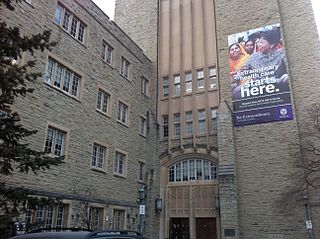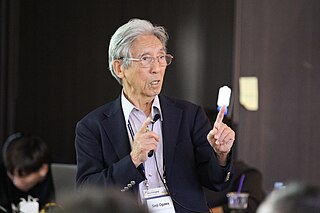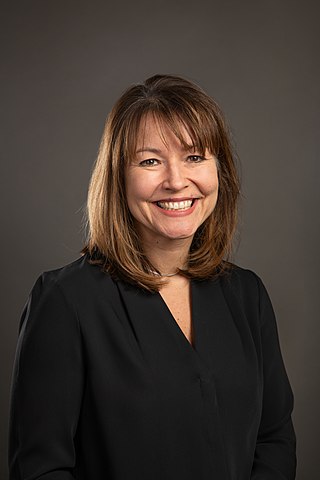
Magnetic resonance imaging (MRI) is a medical imaging technique used in radiology to form pictures of the anatomy and the physiological processes of the body. MRI scanners use strong magnetic fields,magnetic field gradients,and radio waves to generate images of the organs in the body. MRI does not involve X-rays or the use of ionizing radiation,which distinguishes it from computed tomography (CT) and positron emission tomography (PET) scans. MRI is a medical application of nuclear magnetic resonance (NMR) which can also be used for imaging in other NMR applications,such as NMR spectroscopy.

John Parmenter Robarts was a Canadian lawyer and politician who served as the 17th premier of Ontario from 1961 to 1971. He was a member of the Progressive Conservative Party of Ontario.

The Schulich School of Medicine &Dentistry is the combined medical school and dental school of the University of Western Ontario,one of 17 medical schools in Canada and one of six in Ontario. The dental school is one of 2 in Ontario and one of 10 in Canada.

Seiji Ogawa is a Japanese biophysicist and neuroscientist known for discovering the technique that underlies Functional Magnetic Resonance Imaging (fMRI). He is regarded as the father of modern functional brain imaging. He determined that the changes in blood oxygen levels cause its magnetic resonance imaging properties to change,allowing a map of blood,and hence,functional,activity in the brain to be created. This map reflected which neurons of the brain responded with electrochemical signals to mental processes. He was the first scientist who demonstrated that the functional brain imaging is dependent on the oxygenation status of the blood,the BOLD effect. The technique was therefore called blood oxygenation level-dependent or BOLD contrast. Functional MRI (fMRI) has been used to map the visual,auditory,and sensory regions and moving toward higher brain functions such as cognitive functions in the brain.
Kenneth Kin Man Kwong is a Hong Kong-born American nuclear physicist. He is a pioneer in human brain imaging. He received his bachelor's degree in Political Science in 1972 from the University of California,Berkeley. He went on to receive his Ph.D. in physics from the University of California,Riverside studying photon-photon collision interactions.
The Digital Fish Library (DFL) is a University of California San Diego project funded by the Biological Infrastructure Initiative (DBI) of the National Science Foundation (NSF). The DFL creates 2D and 3D visualizations of the internal and external anatomy of fish obtained with magnetic resonance imaging (MRI) methods and makes these publicly available on the web.
Robert Turner is a British neuroscientist,physicist,and social anthropologist. He has been a director and professor at the Max Planck Institute for Human Cognitive and Brain Sciences in Leipzig,Germany,and is an internationally recognized expert in brain physics and magnetic resonance imaging (MRI). Coils inside every MRI scanner owe their shape to his ideas.

Magnetic resonance imaging of the brain uses magnetic resonance imaging (MRI) to produce high quality two-dimensional or three-dimensional images of the brain and brainstem as well as the cerebellum without the use of ionizing radiation (X-rays) or radioactive tracers.
Mark Steven Cohen is an American neuroscientist and early pioneer of functional brain imaging using magnetic resonance imaging. He currently is a Professor of Psychiatry,Neurology,Radiology,Psychology,Biomedical Physics and Biomedical Engineering at the Semel Institute for Neuroscience and Human Behavior and the Staglin Center for Cognitive Neuroscience. He is also a performing musician.

Melvyn Alan Goodale FRSC,FRS is a Canadian neuroscientist. He was the founding Director of the Brain and Mind Institute at the University of Western Ontario where he holds the Canada Research Chair in Visual Neuroscience. He holds appointments in the Departments of Psychology,Physiology &Pharmacology,and Ophthalmology at Western. Goodale's research focuses on the neural substrates of visual perception and visuomotor control.
Kathryn Louise Brush is a Canadian art historian. She is Distinguished University Professor Emerita at the University of Western Ontario,and was the first professor in the Department of Visual Arts at the University of Western Ontario to be named a Fellow of the Royal Society of Canada.
R. Mark Henkelman is a Canadian biophysics researcher in the field of medical imaging,now retired,who was appointed as a Fellow of the Royal Society of Canada (2005) and the Order of Canada (2019) in recognition of his pioneering contributions to the field of magnetic resonance imaging.
Erika A. Chamberlain is a Canadian legal scholar. In 2017,Chamberlain was appointed to a five-year term as Dean of the University of Western Ontario Faculty of Law as a replacement for Iain Scott. Her research focuses on the field of impaired driving law and alcohol-related civil liability.

Lisa Marie Saksida is a Canadian neuroscientist. She is a Professor and Canada Research Chair in Translational Cognitive Neuroscience at the University of Western Ontario's Schulich School of Medicine &Dentistry. Since 2000,Saksida has worked on the development of a touchscreen-based cognitive assessment system specifically for mouse models.

Jessica Adrienne Grahn is an American music neuroscientist. She is the director of the Human Cognitive and Sensorimotor Core of the University of Western Ontario's Brain and Mind Institute. During the COVID-19 pandemic,Grahn was named to the Royal Society of Canada's College of New Scholars,Artists and Scientists.
Carol Pearl Herbert is a Canadian family physician and researcher. She is a member of the National Academy of Medicine,Order of Canada,and Canadian Academy of Health Sciences.
Frank Beier is a German–Canadian orthopedist. He is a Tier 1 Canada Research Chair in Musculoskeletal Research at the University of Western Ontario.
Rebecca Jane Rylett is a Canadian molecular neurobiologist. As of 2019,she is the Scientific Director of the CIHR Institute of Aging. As a Distinguished University Professor at the University of Western Ontario,Rylett also served as an Associate Dean in the Schulich School of Medicine &Dentistry and chair of the Department of Physiology and Pharmacology.
Grace–Eve Párraga is a Canadian lung-imaging scientist. She is a Tier 1 Canada Research Chair in Lung Imaging to Transform Outcomes at the University of Western Ontario.
Kevin Michael Brindle,,is a British biochemist,currently Professor of Biomedical Magnetic Resonance in the Department of Biochemistry at the University of Cambridge and a Senior Group Leader at Cancer Research UK. He is known for developing magnetic resonance imaging (MRI) techniques for use in cell biochemistry and new imaging methods for early detection,monitoring,and treatment of cancer.








